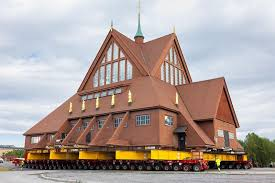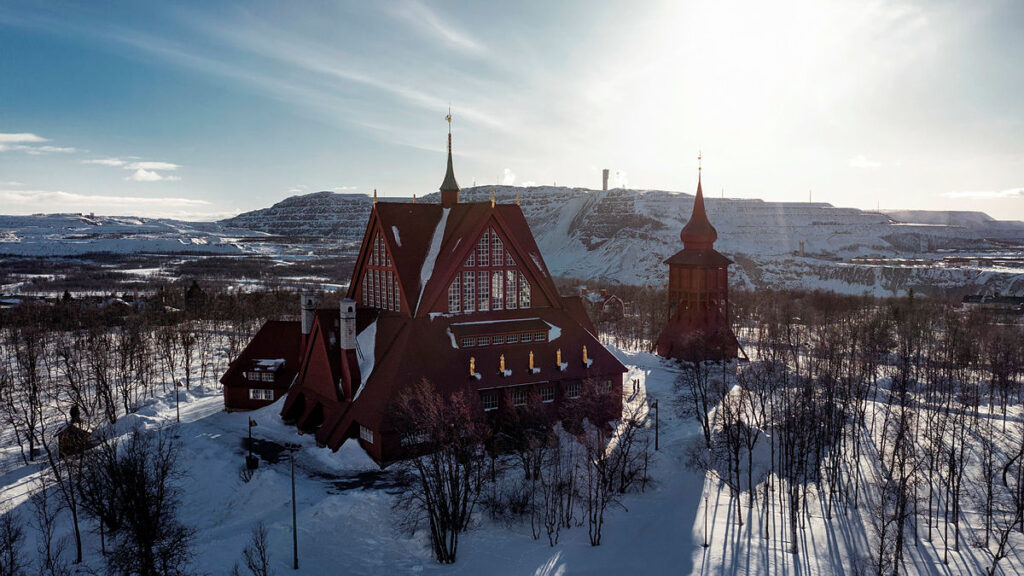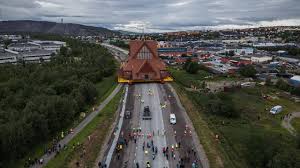ENGINEERING MARVEL: SWEDEN’S 113-YEAR-OLD HISTORIC CHURCH MOVED TO NEW HOME ON WHEELS

The Soul of the City Saved: Kiruna Church, Swallowed by Underground Mine, Successfully Completes Its 5-Kilometer Journey on a 224-Wheeled Platform
KIRUNA, Sweden – Kiruna, famously known as Europe’s northernmost city, is currently the site of an extraordinary urban engineering feat. The entire city is undergoing a phased relocation due to instability caused by the colossal underground iron ore mine beneath its foundations. The most emotionally significant and technologically intricate phase of this unprecedented restructuring involved the relocation of the 113-year-old Kiruna Church (Kiruna Kyrka), often described as the very “soul” and spiritual heart of the community.
Following approximately eight years of detailed planning and a substantial investment exceeding $50 million, the massive, 672-ton historic wooden structure was delicately loaded onto a specially designed 224-wheeled platform and successfully transported 5 kilometers to its designated plot in the new city center. The successful completion of this journey marks a triumphant moment for cultural preservation and advanced logistics.

⚙️ THE REASON FOR RELOCATION: THE GROWING MINE
Kiruna’s entire existence stems from its vast iron ore reserves, which powered its establishment in the early 1900s. However, the continuous expansion and deepening of operations by LKAB, the state-owned mining company, have structurally destabilized the ground. Consequently, while over 1,100 other buildings have been demolished and will be reconstructed, officials deemed several key historical and cultural landmarks too precious to lose.
- Architectural and Spiritual Value: Completed in 1912 by architect Gustaf Wickman, the Kiruna Church Moved became a national symbol. It is revered for its unique blend of Sami (indigenous people) traditional wooden construction and Art Nouveau elements. Furthermore, in a 2001 public vote, it was officially named the “best building of all time” in Sweden, cementing its status as an architectural masterpiece.
- Preservation Decision: Local and national authorities firmly believed that dismantling and reconstructing the church would fundamentally destroy its irreplaceable spiritual and historical integrity. Therefore, they authorized the costly and complex technical procedure to move the entire 40-meter-wide structure as a single piece.

🛣️ THE “GREAT CHURCH WALK”: A TWO-DAY ODYSSEY
The physical relocation of the immense structure took place over two days, commencing on August 19, 2025, and demanded surgical precision from the engineering teams:
- Foundation Preparation: The multi-step process began months in advance. Workers meticulously dug trenches and stabilized the earth surrounding the church. Then, they carefully slid massive metal support beams beneath the entire foundation. These beams acted as the structural cradle for the journey.
- Precision Movement: The 672-ton church was positioned atop the remotely controlled, multi-axle platform. The structure moved at a painstakingly slow and controlled speed, averaging just about 500 meters (roughly one-third of a mile) per hour. This extreme caution was essential to ensure the century-old wood framing experienced minimal stress or vibration.
- Public Fascination: The event, affectionately named the “Great Church Walk,” drew massive public interest. Thousands of spectators lined the streets to witness the historic sight, and the operation received live international media coverage. King Carl XVI Gustaf of Sweden was present to greet the church upon its successful arrival at its new location.
Vicar Lena Tjärnberg held a special consecration service prior to the move, emphasizing the sacred continuity of the structure. Following this engineering triumph, the Kiruna Church Moved will undergo extensive internal restoration before reopening its doors for worship in late 2026. This ambitious project serves as a global example of prioritizing cultural heritage over industrial expediency.






